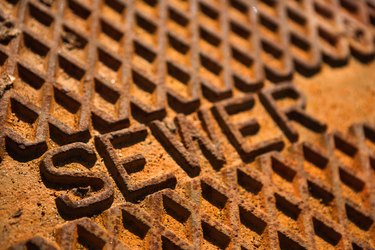
Pipe made of high density polyethylene — such as PE3408 and PE3608 — is used mainly in industrial and municipal applications such as water mains or sewer and storm drains. This kind of pipe must bear up under both high pressure from within and the weight of the earth from above when buried deeply in a trench. HDPE pipe is tested, rated and numbered according to factors such as the amount of stress it can tolerate.
Pipe Numbering
Video of the Day
The American Society for Testing and Materials conducts tests on a variety of construction materials, including polyethylene pipe. The ASTM, in conjunction with the Plastic Pipe Institute, assigns a numerical designation to polyethylene pipe based mainly on the type of resin from which it is made and its resistance to cracking under pressure, or hydrostatic stress. Due to changes in the resins used to make polyethylene pipe the ASTM expanded the classifications, which resulted in a corresponding change in numerical designations. Pipe that was formerly classified under the Thermoplastic Materials Designation Code as PE3408 is now separated into three classes, designated PE3408, PE3608 and PE4710. The first number of the code relates to material density, the second to crack resistance, and the last two indicate the hydrostatic design stress at a specific temperature.
Video of the Day
PE3408
PE3408 has a resin designation of 3, a crack resistance factor of 4, and a HDS of 800 psi at 73F. Because this classification has been in existence for quite some time, it is sometimes included in specifications even when another pipe is actually being used, such as PE3408/3608 or PE3408/4710.
PE3608
PE3608 has the same resin and HDS designation as PE3408. The only difference is that PE3608 has a crack resistance factor of 6. This designation may be misleading, however. Performance Pipe, one of the largest manufacturers of polyethylene piping materials in North America, notes that the ASTM changed the way it assigns a slow crack resistance number in the latest version of ASTM D3350, "Standard Specification for Polyethylene Plastics Pipe and Fittings Materials."
PE4710
High performance resins such as those used to produce PE4710 are one of the reasons the ASTM and PPI changed the ratings and designations. PE4710 is a higher density material, hence the resin designation of 4. It also has a higher stress crack resistance, with a factor of 7. The HDS is 1000 psi at 73F.
Considerations
The subject of specifications, ratings and numerical designations for HDPE pipe is quite complex. This information is used to design, build and maintain safe, long-lasting plumbing and drainage systems. A great deal of study goes into both the ratings and the selection process for this kind of pipe, so seek the opinion of qualified professionals before installing or replacing HDPE pipe in critical applications.